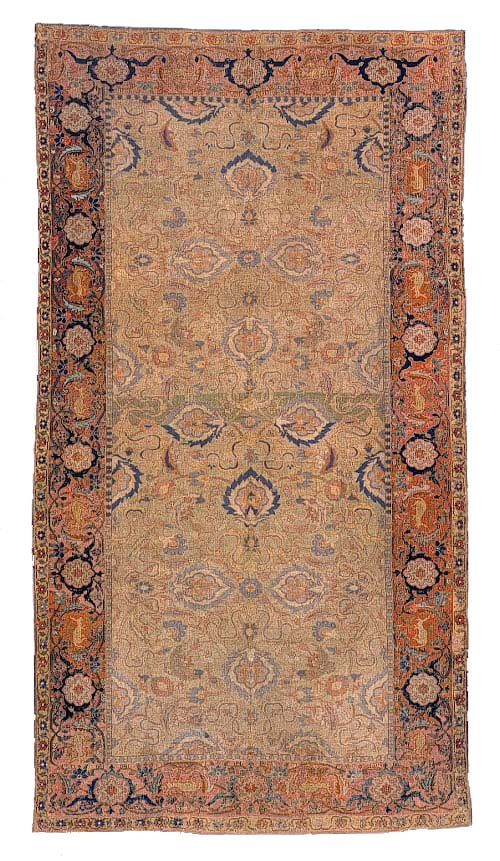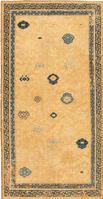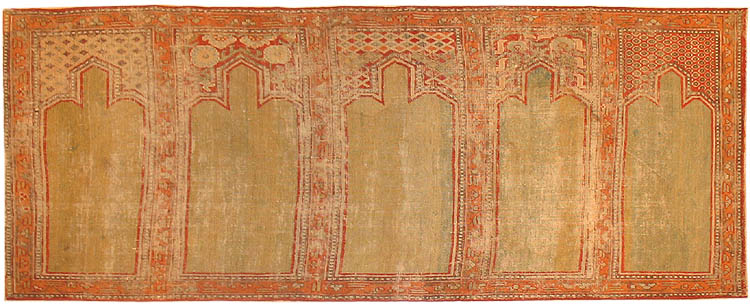Early Period Rugs and Home Decor
 One of the great divides in the rug world is the distinction between newer rugs and those that can be termed antique. This is a distinction that operates on various levels involving artistic and technical quality, rarity, and, of course, price. New rugs are not simply those that arrive in the market direct from a manufacturer without ever having been used, but also those with an age of thirty years or less. Antique rugs are those at least eighty years old, while older and semi-antique rugs fill the gap between the new and antique. But these other categories are of little import; it is the fully antique label that really matters. Antique rugs have hand-spun wool, their colors are made with all or primarily vegetable-derived dyes, and they are produced with designs rooted authentically in traditions hundreds of years old. Unlike new rugs, there is a finite number of rugs made before 1920. This number may shrink, but it can never increase. Antique rugs not only have quality, but rarity as well, and this tends to increase their value with the passing of time.
One of the great divides in the rug world is the distinction between newer rugs and those that can be termed antique. This is a distinction that operates on various levels involving artistic and technical quality, rarity, and, of course, price. New rugs are not simply those that arrive in the market direct from a manufacturer without ever having been used, but also those with an age of thirty years or less. Antique rugs are those at least eighty years old, while older and semi-antique rugs fill the gap between the new and antique. But these other categories are of little import; it is the fully antique label that really matters. Antique rugs have hand-spun wool, their colors are made with all or primarily vegetable-derived dyes, and they are produced with designs rooted authentically in traditions hundreds of years old. Unlike new rugs, there is a finite number of rugs made before 1920. This number may shrink, but it can never increase. Antique rugs not only have quality, but rarity as well, and this tends to increase their value with the passing of time. But there is another divide of this sort, although it is not as well known. This is the divide between rugs designated as antique and those known as Early rugs and textiles, those made before 1800. Given the essential fragility of woven art, rugs of this age in anything approaching good condition are far rarer than antique rugs of the nineteenth and early twentieth centuries. This makes them even more expensive than nineteenth century pieces, but their rarity has also made Early Period pieces somewhat unfamiliar to the larger rug-buying public. Instead, early rugs or carpets and textiles of this kind have so far been primarily of interest to specialist collectors. This is unfortunate, since many early pieces are carpets of a substantial size, which, if in sufficiently good condition, make excellent decorative rugs. For those who can appreciate the particular beauty and superior artistry of Early Period rugs, they remain a largely untapped resource for high quality interior décor. A few examples from the Nazmiyal Collection will suffice to illustrate this point.
17th Century Esfahan, seen above, is a classical Safavid Persian carpet of a type generally attributed to Isfahan, although this has never been proven conclusively. But wherever in Persia this exquisite piece was made some time around 1650, it is an outstanding example of Persian rug weaving at its peak. The field design consists of flame-like, elaborately stylized flowers or palmettes connected by a trellis of fine vines and sinuous cloudbands. Somewhat different palmettes connected by interlacing strapwork vines make up the main border. Those familiar with later antique Persian carpets of the nineteenth century will recognize in this piece the ancestor of many of the great Kermans, Kashans, and Tabriz produced in the decades just before 1900 as part of a widespread revival of Persian rug weaving.
But the classical forerunners lor originals like 17th Century Isfahan Rug have a special quality that sets them apart. Their drawing is meticulous and full of life because their designs were at that time new, cutting-edge artistic creations emanating for the court of the Safavid Persian Shahs. The palette of these classical pieces is also different with its emphasis on soft golds, greens, blues, and terracottas. The colors are saturated and full of depth, but not strong or harsh. The proportions of the rug are a bit narrow for the length, 6 x 12, but still very usable as a room-size carpet. The pile is very low, lower indeed than many antique nineteenth century pieces, as one would expect for a rug over three hundred years old. But the artistic quality and presence of the piece more than compensate for this.
 16th Century Alcaraz is a Spanish carpet probably woven in the town of Alcaraz in the mid sixteenth century. Early Spanish carpets of this type grew out of the production begun earlier in Spain under the rule of the Moors. But immediately following the Reconquista and the expulsion of the Moors by Ferdinand and Isabella in 1492, Spanish carpets abandoned the Islamic patterns of earlier times in favor of more European designs of Renaissance and Greco-Roman derivation like this splendid piece. Elaborate acanthus vinescrolls sprouting delicate palmettes in deep aubergine sprawl as a network across the warm terracotta ground, while a border of dragon-like s-shaped vines encloses the whole composition. This is a carpet that has the richness of a fine textile like a Renaissance silk brocade or velvet. At approximately 5 x 10 it too would make an excellent room-size rug even though it is also a first rate museum piece.
16th Century Alcaraz is a Spanish carpet probably woven in the town of Alcaraz in the mid sixteenth century. Early Spanish carpets of this type grew out of the production begun earlier in Spain under the rule of the Moors. But immediately following the Reconquista and the expulsion of the Moors by Ferdinand and Isabella in 1492, Spanish carpets abandoned the Islamic patterns of earlier times in favor of more European designs of Renaissance and Greco-Roman derivation like this splendid piece. Elaborate acanthus vinescrolls sprouting delicate palmettes in deep aubergine sprawl as a network across the warm terracotta ground, while a border of dragon-like s-shaped vines encloses the whole composition. This is a carpet that has the richness of a fine textile like a Renaissance silk brocade or velvet. At approximately 5 x 10 it too would make an excellent room-size rug even though it is also a first rate museum piece.  From the other side of the world comes 17th century Ningsia, a magnificent Ningshia carpet made in an imperial workshop in seventeenth century China. At first glance the field looks fairly open with a scatter or small rosette-like Chinese cloud motifs in shades of blue. In actuality the field contains a lush allover vinescroll, but it barely shows up given its subtle tone-on-tone coloration is shades of golden tan. The two narrow borders of half-rosettes and fretwork provide a reserved, understated frame for the subtlety of the field. More than three hundred years have not been able to compromise in the least the sumptuous decorative effect of this wonderful carpet.
From the other side of the world comes 17th century Ningsia, a magnificent Ningshia carpet made in an imperial workshop in seventeenth century China. At first glance the field looks fairly open with a scatter or small rosette-like Chinese cloud motifs in shades of blue. In actuality the field contains a lush allover vinescroll, but it barely shows up given its subtle tone-on-tone coloration is shades of golden tan. The two narrow borders of half-rosettes and fretwork provide a reserved, understated frame for the subtlety of the field. More than three hundred years have not been able to compromise in the least the sumptuous decorative effect of this wonderful carpet.  18th Century Yankand is a saph or multiple niche communal prayer rug of the eighteenth century from East Turkestan to the West of Tibet. Each of the panels is a mihrab, an arch-shaped door or window onto paradise. Although the piece was made for communal worship the ornamental treatment of the details has considerable decorative effect as a runner some nine feet long. The dyes on this piece, especially the green, are simply superb, endowing it with a jewel-like mosaic quality. In view of its delicate condition it would now serve more appropriately as a wall hanging that could provide the illusion of a row of windows.
18th Century Yankand is a saph or multiple niche communal prayer rug of the eighteenth century from East Turkestan to the West of Tibet. Each of the panels is a mihrab, an arch-shaped door or window onto paradise. Although the piece was made for communal worship the ornamental treatment of the details has considerable decorative effect as a runner some nine feet long. The dyes on this piece, especially the green, are simply superb, endowing it with a jewel-like mosaic quality. In view of its delicate condition it would now serve more appropriately as a wall hanging that could provide the illusion of a row of windows. Early rugs and textiles are certainly not the esoteric “collector items” that they are so often taken to be. They were originally produced as decorative interior furnishings at an elite level of patronage. There is no reason, therefore, that should not function in this way today, so long as they are sufficiently well preserved and treated with care. They offer a superior degree of elegance and artistry that is a notch or two above most nineteenth century rugs. For those discerning enough to tell the difference and willing to pay for it, Early Period rugs are a gateway to a lost era of grace and luxury.
No comments:
Post a Comment